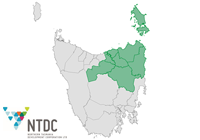This indicator shows the estimated number of employed residents of the local area, on an annual basis back to 2001. Employed residents may have a workplace anywhere, inside or outside the area. The dataset is derived from the National Economics microsimulation model, based on the ABS labour force survey.
A growing number of resident employed can indicate a growing economy, or a growing residential population, supplying labour to other areas. To build a more complete picture of the residential economy, this dataset should be viewed in conjunction with Local employment, Employment self-containment, Residents place of work by industry and Residents place of work by occupation datasets.
Current area:
Current benchmark:


| Employed residents | |||||||
|---|---|---|---|---|---|---|---|
| Northern Tasmania Region | Tasmania | ||||||
| Year (ending June 30) | Number | % change | Number | % change | Northern Tasmania Region as a % of Tasmania | ||
| 2024 | 75,863 | -0.93 | 283,937 | -0.43 | 26.72 | ||
| 2023 | 76,573 | +2.60 | 285,159 | +2.51 | 26.85 | ||
| 2022 | 74,635 | +3.96 | 278,167 | +4.00 | 26.83 | ||
| 2021 | 71,791 | +3.50 | 267,460 | +2.88 | 26.84 | ||
| 2020 | 69,367 | +1.81 | 259,961 | +1.96 | 26.68 | ||
| 2019 | 68,134 | +0.55 | 254,972 | +1.22 | 26.72 | ||
| 2018 | 67,759 | +3.54 | 251,895 | +4.15 | 26.90 | ||
| 2017 | 65,443 | +1.19 | 241,848 | +1.29 | 27.06 | ||
| 2016 | 64,671 | -1.06 | 238,767 | -0.39 | 27.09 | ||
| 2015 | 65,361 | +2.21 | 239,702 | +2.92 | 27.27 | ||
| 2014 | 63,950 | -1.18 | 232,912 | -0.36 | 27.46 | ||
| 2013 | 64,715 | -1.44 | 233,761 | -1.01 | 27.68 | ||
| 2012 | 65,664 | -1.64 | 236,136 | -1.26 | 27.81 | ||
| 2011 | 66,759 | +1.09 | 239,146 | +1.29 | 27.92 | ||
| 2010 | 66,037 | -1.40 | 236,105 | -1.39 | 27.97 | ||
| 2009 | 66,978 | +3.41 | 239,433 | +3.19 | 27.97 | ||
| 2008 | 64,766 | +2.24 | 232,020 | +3.00 | 27.91 | ||
| 2007 | 63,350 | +0.43 | 225,261 | +0.94 | 28.12 | ||
| 2006 | 63,077 | +2.76 | 223,165 | +3.17 | 28.26 | ||
| 2005 | 61,383 | +1.95 | 216,307 | +2.49 | 28.38 | ||
| 2004 | 60,207 | +5.05 | 211,042 | +4.62 | 28.53 | ||
| 2003 | 57,315 | +1.23 | 201,722 | +1.53 | 28.41 | ||
| 2002 | 56,618 | -0.12 | 198,686 | -0.95 | 28.50 | ||
| 2001 | 56,687 | -- | 200,586 | -- | 28.26 | ||
Source: National Institute of Economic and Industry Research (NIEIR) ©2025. Compiled and presented in economy.id by .id (informed decisions). NIEIR-ID data are adjusted each year, using updated employment estimates. Each release may change previous years’ figures. Learn more Please refer to specific data notes for more information | |||||||
